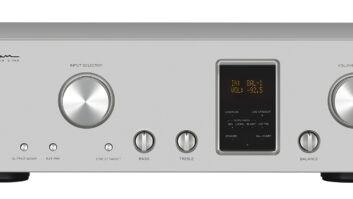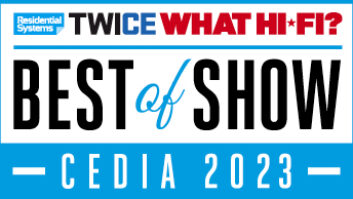Equipment life. It’s simple phrase, but one that rarely pops into the minds of homeowners so dazzled by the home entertainment system that the thought of it malfunctioning due to a power incident is not much of a consideration. For years, integrators and power management manufacturers have been on a mission to raise the profile of this element of installation projects, highlighting the tragic consequences of power surges and spikes and the less frightening upside of energy savings. The fact that power management isn’t very glamorous, at least not in the way electronic buffs tend to like their equipment, has made selling it slightly trickier than pitching the products it protects.

Panamax/Furman raises the enthusiasm levels of its dealer base around power management with the “bringing the lab to the showroom” approach, which is a set of demonstrations to underscore the benefits of its plug-and-play, internet-connected technologies.
“A ‘good installation’ means different things to different people,” noted Marshall Currier, national trainer for Panamax/Furman. “To a homeowner, it can mean their expectations have been met for their elaborate new environment, with seamless interoperability between an array of technologies. To an integrator, a good installation is not only on time and at (or under) budget, it also provides zero downtime from connection issues and handshake problems, and exhibits bulletproof reliability to keep service calls to a minimum.

Alex Foster, comptroller for the integration company Sundown One in Illinois, said his company is honest in saying that a system will still work without power management, “but most think it’s nice having a product that will completely ensure a system is protected from lightning and surges.”
“Power management helps ensure a good installation for customers and installers alike,” he continued. “It allows equipment to perform reliably, reduces performance-robbing electronic noise while regulating power fluctuations, and reduces failures, so less equipment has to be replaced over time, saving money for all parties.”
Selling Power Management
Is selling power management as difficult as we have come to believe, though? Eric Schmidt, founder and CEO of Illinois-based integration firm Sound & Vision, doesn’t think so, calling that perception “completely imagined.”
“Selling power management represents the age-old phenomena of selling from one’s own pocketbook and not the client’s,” Schmidt explained. “Certainly there will always be clients that just can’t see the value in it, no matter what you do. But that’s not an issue of cost, and you won’t know they’re immovable on the idea if you haven’t tried.”
Schmidt, who is a dealer for Panamax/ Furman, said his firm simply does not make power management optional, and clients, seeing their conviction on the matter, often go with their expertise.
To instill this kind of confidence in integrators to sell the necessity of power management to end-users, manufacturers have come up with several ways to help the pitching go more smoothly.
Panamax/Furman, for example, raises the enthusiasm levels of its dealer base around power management with the “bringing the lab to the showroom” approach, which is a set of demonstrations to underscore the benefits of its plug-and-play, internet-connected technologies, such as the BlueBOLT platform, and side-byside comparisons with competitor products showing how each unit handles different types of electrical surges.
“A lot of integrators we work with make it standard practice to ask their client ‘What are you plugging this into,’” Currier said, “and specify power management to ensure they can stand behind the longevity and performance.”
Middle Atlantic’s three-tier solution includes power management solutions for every budget, as well as extensive training on and access to products to show to clients.

Middle Atlantic’s RackLink products not only provide power protection and monitoring, but they can also detect a problem situation and take action to correct the problem on their own.
“Today, we offer far more sophisticated power management function and products tailored for AV,” said Kevin Handerson, Middle Atlantic’s marketing director. “These products have taken the next step to what we think of as ‘intelligent power management.’ For example, our RackLink products not only provide power protection and monitoring, but they can also detect a problem situation and take action to correct the problem on their own to provide a higher level of system reliability. No matter the size of the installation, there is an appropriate solution available for integrators.”
Though he doesn’t share Schmidt’s view that the difficulty of selling power management is imagined, Alex Foster, comptroller for the integration company Sundown One in Illinois, said, “We’re honest in saying the system will still work without it, but most think it’s nice having a product that will completely ensure a system is protected from lightning and surges,” Foster said. “That confidence leads to sales.”
Foster’s belief in SurgeX is aided by what the company’s VP of sales, Rick Komendera calls “multimedia collateral” that does three things: explain SurgeX’s surge elimination technology, serve as a tool for training, and provide clients with evidence that proves SurgeX’s products play a necessary role in their installation. The company also offers online training modules and full technical support to integrators.
“Our website has a ‘knowledge base’ where whitepapers can be downloaded, as well as a power conditioning glossary, global voltage chart, and more,” Komendera said. “We also send these out to our integrators to provide a little extra knowledge for educating staff and clients. Understanding the benefits definitely helps the pitches.”

SurgeX’s “multimedia collateral” strategy does three things: explain SurgeX’s surge elimination technology, serve as a tool for training, and provide clients with evidence that proves SurgeX’s products play a necessary role in their installation.
Standing on the “protect your investment” mound of pitches, Mark Mable, of Boston’s Maverick Integration, added that promoting the enhanced performance of products that are integrated with power management has also yielded better sales.
“We also use power management to allow our client’s to cycle power on devices that frequently glitch–such as cable television boxes–all from their in-wall or wireless touchpanels and save that long walk down to the basement,” said Mable, who is a Torus Power dealer. “Power management can also allow us to remotely service a system through re-boot capability and often will save the roll of a truck. Once they understand the benefits of power management, our clients rarely push back on the expense.”
In addition to the requisite training and a range of products to hit varying price points and power supply loads, Torus Power offers its dealers and integrators special pricing terms for demonstration samples.
“In the absence of proper power conditioning, end-users may experience equipment failures, shorter equipment life, and/or poor audio video performance,” noted Matt Roher, Torus Power’s development manager. “Integrators will likely have a higher number of service calls, which can be very costly both from a dollars standpoint and in forgone sales opportunities elsewhere. With so many ancillary costs, it is often more economical for both the integrator and the end-user to make the investment and save time and money while also gaining premium audio video performance.”

Mark Mable, of Boston’s Maverick Integration, said that promoting the enhanced performance of products that are integrated with power management has yielded better sales.
Defining Future Energy
It would be a mistake to discuss power management exclusively from a home entertainment integration perspective. With the United States on its way to revamping its power grid system, in addition to the myriad new regulations and incentives redefining consumer power usage, power management’s ancillary role in our industry has been its ability to help consumers get on top of energy conservation.
“Understanding how overtaxed today’s power grids are is very important because U.S. consumer demands have gone beyond simply needing electricity for light bulbs and basic appliances,” said Dennis Mariasis, AV business development and brand manager of Tripp Lite. “Understanding this helps the dealer explain to his customer how sensitive to damage all of their shiny new products are to even a minor voltage swing or brownout.”
As Currier noted, consumers won’t adjust their habits unless they’re given a compelling reason to do so, making the connection that reading power usage should become as simple as understanding the cost of a gallon of milk. Across the board, power manufacturers are well aware of the significance of their products to the future.
“New products will emerge to specifically address the challenges of renewable energy, as well as increase monitoring and management capabilities,” Komendera predicted. “It’s a good sign that a growing number of people care about their power consumption habits, so a major transition toward easier monitoring, management, and saving will largely define the category. It’s a bright future, though surge suppression and power protection will remain relevant because in 10 years, our still-aging electrical grid will face a lot of the same issues.”
Llanor Alleyne is a contributing editor to Residential Systems in Brooklyn, NY.







